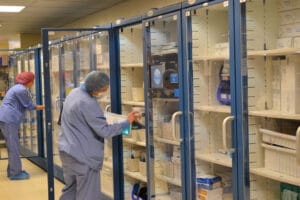 More than ever, today’s healthcare environment is calling for hospitals and health systems to rein in their costs. With all of the pressures of Covid-19 placed on top of prior concerns such as declining reimbursements and the shift to value-based care, hospitals are quickly looking to reduce costs while maintaining high standards of care.
More than ever, today’s healthcare environment is calling for hospitals and health systems to rein in their costs. With all of the pressures of Covid-19 placed on top of prior concerns such as declining reimbursements and the shift to value-based care, hospitals are quickly looking to reduce costs while maintaining high standards of care.
One area that is ripe for extreme waste reduction is supply management. Supplies are the second highest expense bucket for hospitals after labor and they are often managed with inefficient processes and outdated technologies. Across a large hospital or a health system, these inefficiencies can result in tens of millions of dollars in waste each year. The waste can come from several factors including overstocked inventories, losses from product expirations, missed charge capture and labor inefficiencies, which combined can exceed 8 figures in value for larger healthcare providers.
Even if we know that large academic medical centers and integrated health networks are experiencing such losses each year, what can they do? The best solution is an automated supply tracking system that increases the quality of documentation while simultaneously reducing the effort required to complete that same documentation. Many hospitals and health systems today are evaluating RFID-based supply tracking systems for the following reasons:
- They reduce the costs from overstocking. Smart, RFID-based supply tracking systems are able to track real-time inventories without reconciliations, and keep an accurate record of inventory usage. With this data, these systems offer up valuable insights that help to continuously improve PAR levels and optimize stocking levels. Hospitals typically suffer from overstocking or hoarding as a reaction to running out of stock when it is most needed. By having great data and planning properly, inventory levels can be minimized while ensuring stockouts no longer happen.
- They improve documentation in EMRs. Because electronic medical records have been such a large investment for hospitals over the last decade, hospitals are always on the lookout for ways to improve the quality of their EMR documentation. Setting up an interface with the EMR will improve quality by electronically documenting supply usage in the patient medical record. This reduces the amount of time clinicians need to spend documenting supplies and also reduces human errors. This allows clinicians in the room during procedures to focus on patient care rather than manually documenting the supplies used.
- They increase efficiency for materials management staff. Advanced supply tracking systems reduce the amount of manual work required to manage and re-order supplies. The biggest time savers are the elimination of reconciling inventory to produce an accurate on-hand inventory count and reduction in “eyeballing” inventory for daily re-orders. Additionally, setting up an interface with the materials management system will automatically re-order inventory and reduce the time employees spend managing inventory. As mentioned before, the right system will even recommend optimal PAR levels, saving staff even more time.
- They capture more charges. With an advanced supply tracking system, billings for procedures will improve because of the highly accurate records of items being used for patients. This will increase charge capture and resulting reimbursements for supplies and provide a large ROI on the investment required to bring in the system. In fact, this will be the single biggest financial improvement from an advanced supply tracking system, as hospitals tend to miss billing for around 15% of their used supplies. After all, if an item is not documented then it cannot be billed for, and these systems greatly improve supply documentation.
- They standardize processes and data. A large initiative that most large hospitals and health systems are currently undertaking is the standardization of their systems and processes. By moving to standardization, hospitals can eliminate differences from department to department and health systems can eliminate differences from hospital to hospital. These changes will reduce the time it takes to train and implement these systems once they are established. They will also standardize the data coming out of their system so that it becomes easy to compare performance across departments and hospitals. With this data in hand, hospitals can determine best practices and implement them across the board to constantly improve performance.
Implementing an enterprise-wide supply tracking system is one move large hospitals and health systems can make to improve their finances while standardizing processes and data. If your hospital or health system currently lacks the ability to reap the benefits mentioned above, consider a system such as iRISupply. The system uses RFID technology to keep a perpetually accurate count of inventory and captures patient to supply association right at the point of dispensing from the cabinet. The smart cabinets, when combined with interfaces to the EMR and materials management system, greatly reduce the documentation burden on clinicians while improving data flow throughout the hospital or health system. Additionally, the system’s powerful, built-in analytics allow for continuous improvement by providing real-time statistics about your inventory. For example, you can identify slow-moving or unused items that may need adjustments, leading to a more efficient and profitable operation.
Subscribe to our Newsletter
